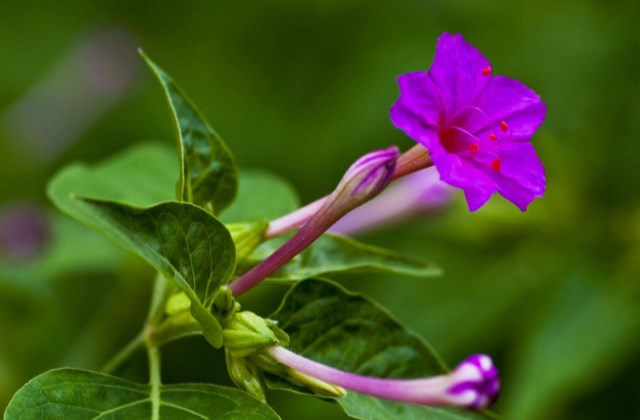
Mirabilis (scientific name: Mirabilis jalapa L.): herb, up to 1 meter high. The roots are fat and thick, obconical, black or dark brown. Stem erect, cylindrical, much branched, glabrous or sparsely pubescent, nodes slightly enlarged. Leaves ovate or ovate-triangular, entire, glabrous on both surfaces, with raised veins. Flowers clustered at the end of branches, involucre bell-shaped, about 1 cm long, 5-lobed, lobes triangular-ovate; perianth purple, yellow, white or variegated, tall saucer-shaped, tube length 2-6 cm, The eaves are 2.5-3 cm in diameter, 5-lobed; the flowers bloom in the afternoon with fragrance, and wither before noon the next day. Achene spherical, 5-8 mm in diameter, leathery, black, surface wrinkled; seed endosperm white and powdery. The flowering period is June-October, and the fruiting period is August-November.
Native to tropical America. It is often cultivated in various places in the north and south of China as ornamental flowers, and sometimes it is wild. The roots and leaves are used for medicinal purposes, and have the effects of clearing away heat and detoxification, promoting blood circulation and regulating menstruation and nourishing. Seed white powder can remove moles and acne on the face.
Mirabilis is easy to grow, and the maintenance and management are relatively extensive. Appropriate fertilization and watering are enough during the growth period.
Since Mirabilis is pollinated by wind, it is very easy to hybridize between varieties. In order to ensure that the harvested seeds can maintain excellent characteristics, different varieties should be cultivated in isolation.
Mirabilis likes a warm climate, and the soil requires loose, fertile, deep, humus-rich loam into sandy soil is better. The daily management of Mirabilis is relatively simple. Spray some water in the evening on sunny days, and topdress with thin fertilizer 1-2 times a week in the evening, which is conducive to normal growth. There are fewer pests and diseases, and dry weather is prone to aphids. Pay attention to moisturizing at ordinary times to prevent aphids. Cultivate it in flower beds and gardens, and no pests and diseases have been found for many years. The daily management is relatively simple, spray some water in the evening on sunny days, and topdress with thin fertilizer 1-2 times a week in the evening, which is conducive to normal growth. Cultivated in flower beds and gardens, no pests and diseases have been found for many years.
